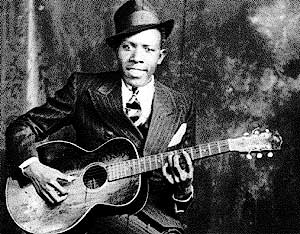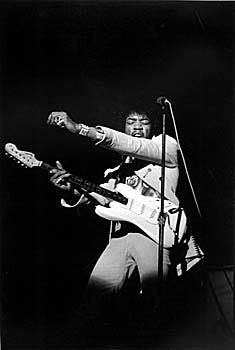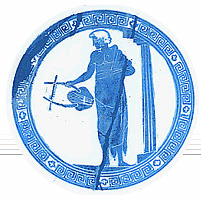|
BLUES
The
blues or the saying "having the blues" can be traced
back to the 16th Century. When someone felt sad they were
said to have "blue devils" attacking them. The sadness
that American slaves felt during the 1870s-90's from over
work, abandonment, discrimination, betrayal and sometimes
lost love was relieved by singing about that sadness. This
singing (and later accompanying with banjo or guitar) was
an attempt to overcome these blues by creating a musical form
and delivering it with a certain sound and spirit we know
today as the blues.
| WORK
SONGS |
 |
|
 |
Even
after the end of slavery Black-Americans worked in less than
ideal conditions either picking cotton, hammering railroad
ties or chopping trees. During this work a pace was kept up
by singing a kind of work song called a "field holler."
A field holler was a song that featured a leader calling out
the beginning of a musical phase and having the other workers
responding by joining in shortly thereafter. This type of
singing is called "call and response." When blues
first started the early blues pieces were patterned after
these work songs but performed and heard after work hours
at the end of the day. The lyrics were very personal and close
to the feelings of each singer. Certain blues numbers were
eventually even danced to.
| BLUES
FORM |
 |
|
 |
There
is some variety within blues forms but the standard and most
common sequence consists of a series of three-line stanzas
in which the first two lines are the same. For example:
I
went to the cross road, fell down on my knees
I went to the cross road, fell down on my knees
Asked the Lord above, "Have mercy, save poor Bob, if
you please."
Each
line is set to four measures, or bars, of music. Each verse
is set to 12 bars of music. These twelve bars divide the three
lines into four bars stanzas each.
The pattern is known as 12-bar blues.
| |
|
MEASURE
1 |
MEASURE
2 |
MEASURE
3 |
MEASURE
4 |
| Line
1 |
 |
I |
I |
I |
I |
| Line
2 |
|
IV |
IV |
I |
I |
| Line
3 |
|
V |
IV |
I |
I |
|
The
roman numeral format above is the harmonic progression that
most blues follows. Notice that it is only three chords; the
tonic (I), the subdominant (IV) and the dominant (V). The
numbers refer to the steps of the scale the chord is built
on.
The
meter of blues is usually duple but in the rhythmic back ground
there is a suggested triplet or three pattern (a subtle compound
meter). The danceable blues are faster in tempo and the personal
type blues numbers are slow and melancholy. The melodies used
in blues are drawn from the "blues scale" which
features a downward bending (sighing or crying affect) of
the third, fifth and seventh scale steps. The texture of blues
is usually homophonic in that a single melodic line is accompanied
by a guitar or later a band. The most important instrument
besides the voice is the guitar (originally acoustic then
electric). Sometimes a blues player will use a "slide"
on the left hand. The slide allows the guitarist to slide
between notes adding a cry or sigh to the melody.
| COUNTRY
BLUES |
 |
|
 |
From
1900 until 1930 African-Americans came from miles away to
the Mississippi Delta (The delta area from Memphis, Tennessee
to Vicksburg, Mississippi) to work clearing land for farming,
building levees to discourage the Mississippi river from escaping
its banks and clearing forests. Within the life of the delta
was the black musician singing the blues. These blues singers
were either traveling workers who sang the blues as they moved
from job to job or professionals who sang at parties, established
places such as clubs or cafes, or simply played at docks or
street corners.
These
early country blues singers used their voice, with guitar
accompaniment and sometimes harmonica to tell stories (called
ballads or talking blues), sing work songs and write dance
tunes.
Listen
to Robert Johnson perform his Mississippi
blues, Crossroads:
Robert
Johnson (1911-1938) was born in Hazlehurst, a small town just
southeast of the Mississippi delta. He began his life as a
sharecropper at a large plantation but in 1930 he decided
to leave and make a career as a professional musician. The
subject of the song Crossroads is how Robert Johnson as a
young man walks out to a crossroads at midnight with his guitar,
and a mysterious large black man appears out of nowhere and
strikes a deal that if Robert Johnson sells his soul to the
devil he will be learn to play the blues just fine.

Robert
Johnson (1911-1938) |
| CHICAGO
BLUES |
 |
|
 |
Due
to increased industrial demand North of where rural blues
was thriving many black workers and their families left the
South for work in the North. Chicago was home to large steel
mills and meatpacking factories. As black workers moved north
so did musicians. Since bars and clubs were nosier in Chicago
most blues musicians had to be amplified in order to be heard
well. The electric guitar was invented by Les Paul in the
1930's and this instrument became the defining sound of amplified
blues. When white folks began to listen to this new amplified
music and when they listened (sometimes secretly) to recordings
over the radio the audience for the blues started to grow.
By the 1950s this led inevitably to rock and roll.
Listen
to the Hoochie Coochie Man, Chicago Blues
of Muddy Waters:
| CONTEMPORARY
BLUES |
 |
|
 |
Today
a new breed of blues guitarists and blues musicians are playing
the blues by not only reviving the tradition of their "grandparents"
but also keeping alive the art form. Black musicians have
not stopped singing the blues and as other styles such as
Jazz, R&B, rock and rap have borrowed from the blues its
purest form is still practiced.

Jimi
Hendrix (1942-1970) |
Listen
to Red House blues by Jimi Hendrix:
|





